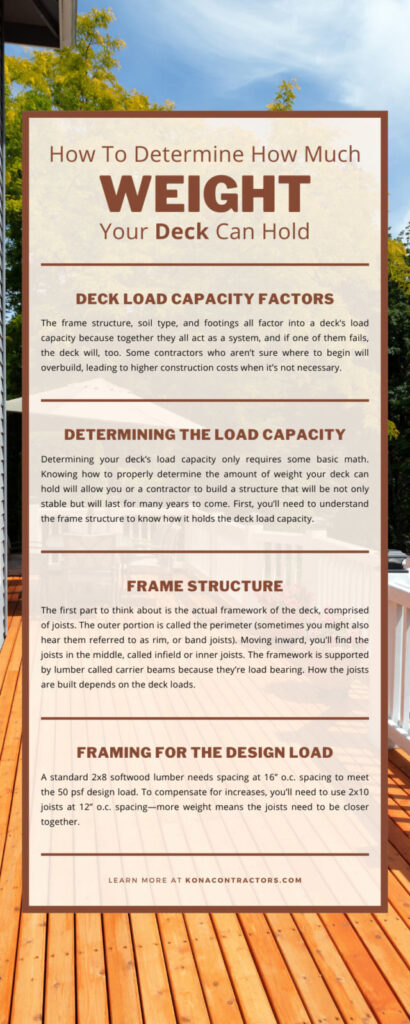
A balcony can be a wonderful addition to your home, providing a space for relaxation, entertaining, or simply enjoying the view. However, it’s crucial to understand how much weight a balcony can hold to ensure its safety and prevent potential accidents. Overloading a balcony can lead to structural damage, posing a serious risk to you and those around you. This article will delve into the factors influencing balcony load capacity, explore relevant building codes, and provide tips for safe balcony usage.
This comprehensive guide will walk you through the essential considerations when determining how much weight a balcony can hold. We’ll examine the various factors that contribute to its load-bearing capacity, discuss the importance of adhering to building codes, and offer practical advice on how to use your balcony safely and responsibly.
Balcony Load Capacity
The load capacity of a balcony refers to the maximum amount of weight it can safely support without compromising its structural integrity. This weight limit is determined by several factors, including the materials used in its construction, the design specifications, and the overall condition of the balcony. Understanding this limit is crucial for preventing overloading and potential accidents.
Balconies are typically designed to withstand a specific amount of weight, often expressed in pounds or kilograms per square foot. This figure represents the maximum distributed load that the balcony structure can safely handle. Exceeding this limit can put undue stress on the supporting beams, joists, railings, and decking, potentially leading to cracks, sagging, or even collapse.
It’s important to note that the actual load capacity of a balcony may vary depending on its age, maintenance history, and any modifications made over time. Factors such as weather exposure, wear and tear, and improper repairs can weaken the structural integrity of a balcony, reducing its safe weight limit.
Factors Affecting Weight Limit
Several factors influence how much weight a balcony can hold, making it essential to consider these variables when assessing its load capacity.
Material Composition
The materials used in constructing a balcony play a significant role in determining its weight-bearing capacity. Stronger materials like reinforced concrete, steel, or pressure-treated lumber can support heavier loads compared to weaker materials such as wood framing alone. The thickness and quality of the materials also contribute to the overall strength and load capacity.
Design Specifications
The design of a balcony, including its shape, size, and supporting structure, directly affects its weight limit. Balconies with larger surface areas or deeper overhangs require stronger support systems to handle increased loads. The spacing between joists, the type of railing system, and the foundation’s strength all contribute to the overall load-bearing capacity.
Age and Condition
The age and condition of a balcony significantly impact its weight limit. Over time, balconies can deteriorate due to exposure to weather elements, wear and tear, or improper maintenance. Cracks, rot, rust, or loose connections can weaken the structural integrity, reducing the safe load it can support. Regular inspections and timely repairs are crucial for maintaining the safety and longevity of a balcony.
Building Codes and Regulations
Building codes and regulations play a vital role in ensuring the safety and structural integrity of balconies. These codes establish minimum standards for materials, design specifications, and construction practices to prevent overloading and potential accidents. Local building departments enforce these codes, requiring permits and inspections throughout the construction process.
It’s essential to consult your local building codes to determine the specific requirements for balcony construction and load capacity in your area. These codes often specify the maximum weight allowed per square foot, taking into account factors such as the type of materials used, the design of the balcony, and the intended use.
Structural Engineer Consultation
When in doubt about how much weight a balcony can hold, it’s always best to consult with a qualified structural engineer. These professionals have the expertise to assess the specific characteristics of your balcony, including its materials, design, age, and condition. They can perform load calculations and provide an accurate determination of the safe weight limit for your balcony.
A structural engineer can also identify any potential weaknesses or areas of concern that may require reinforcement or repair. Their recommendations can help ensure the safety and longevity of your balcony, preventing costly damage and accidents in the future.
Safe Balcony Usage Tips
To maximize the safety and lifespan of your balcony, follow these practical tips for responsible usage:
- Distribute weight evenly: Avoid placing heavy objects in concentrated areas on the balcony. Distribute furniture, potted plants, and other items evenly across the surface to prevent overloading specific sections.
- Avoid exceeding the load limit: Be mindful of the maximum weight your balcony can safely support. Do not overload it with excessive furniture, equipment, or people.
- Inspect regularly for damage: Periodically check your balcony for signs of wear and tear, such as cracks, loose railings, or sagging decking. Report any issues to your building management or a qualified professional for prompt repair.
- Secure loose objects: Use appropriate anchors or tie-downs to secure furniture, planters, and other items on the balcony to prevent them from blowing away in strong winds.
Conclusion
Understanding how much weight a balcony can hold is crucial for ensuring its safety and preventing potential accidents. By considering the factors influencing load capacity, adhering to building codes, and following safe usage practices, you can enjoy your balcony as a comfortable and secure space for relaxation and entertainment. Remember, when in doubt, consult with a qualified structural engineer for an accurate assessment of your balcony’s weight limit and any necessary repairs or modifications.
